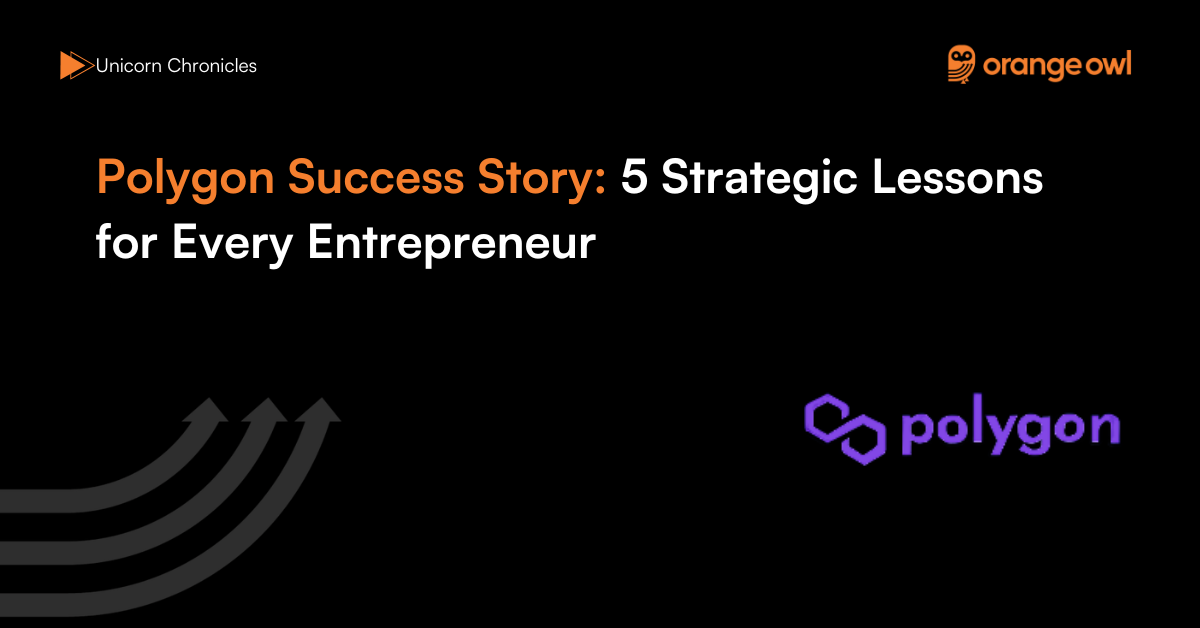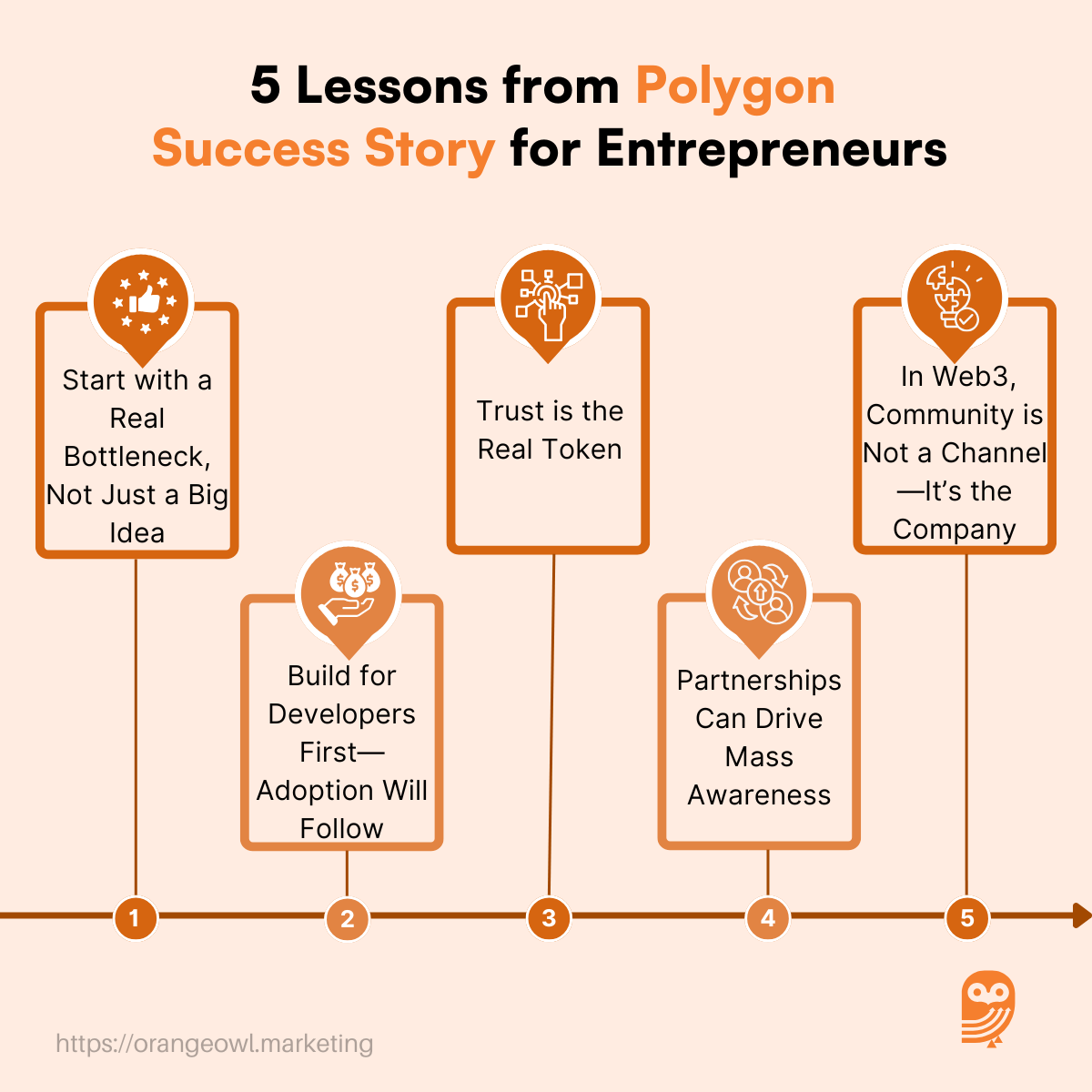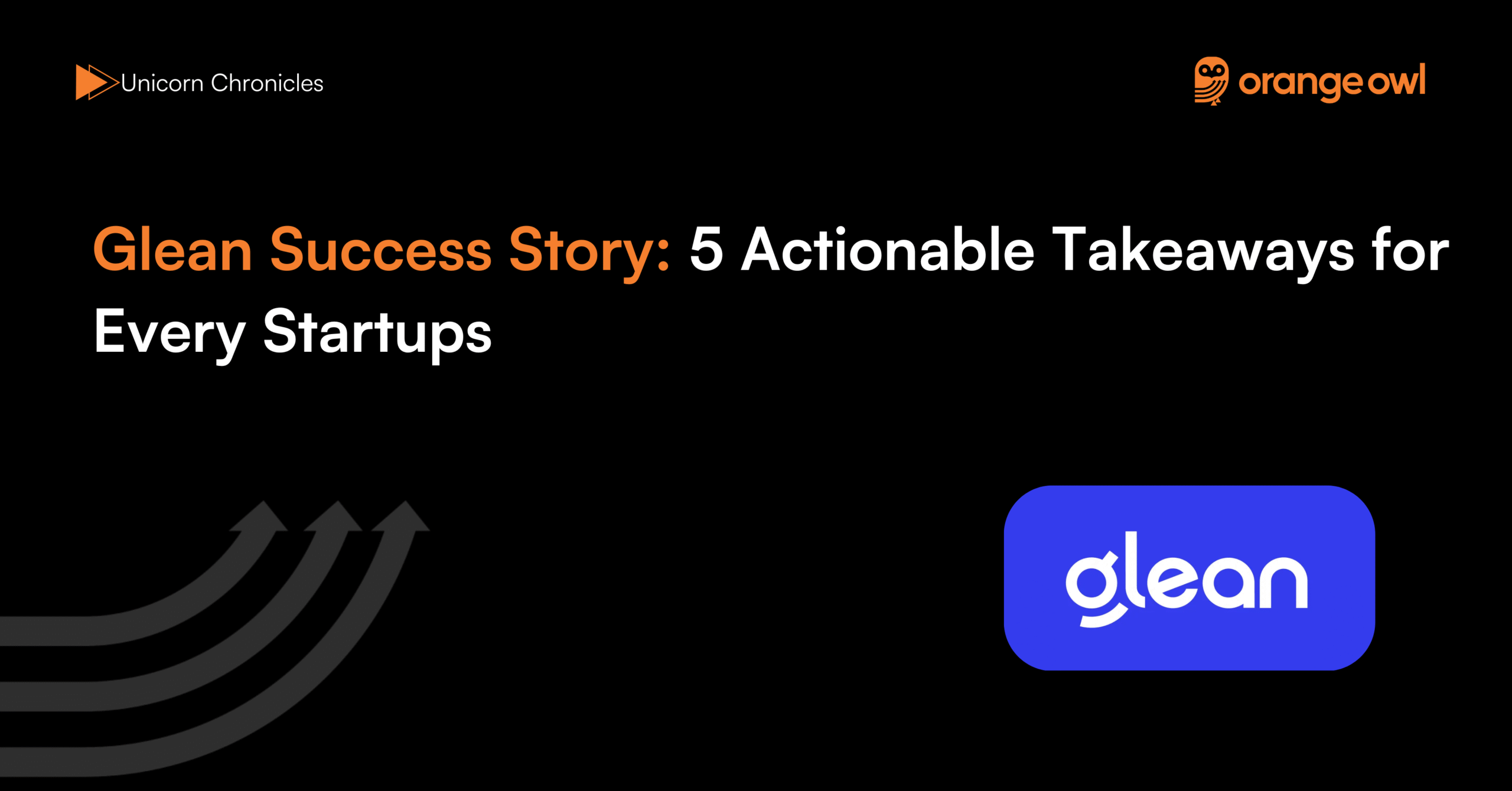Polygon Success Story: 5 Strategic Lessons for Every Entrepreneur
Vivek Goel
June 11, 2025

Table of Contents
Introduction
In the blockchain world, Polygon (formerly Matic Network) has achieved an extraordinary feat—emerging as a $20 billion‑valued Layer‑2 and interoperability powerhouse that’s reshaping how developers build scalable, secure blockchain solutions. Founded in 2017 by technology pioneers Sandeep Nailwal, Jaynti Kanani, Anurag Arjun, Daniel Lubarov, Mihailo Bjelic, Antoni Martin, David Z, Jordi Baylina, Brendan Farmer, and Bobbin Threadbare, Polygon was built with a singular vision: to decentralise and democratize access to blockchain infrastructure.
At its core, Polygon addresses one of crypto’s most pressing challenges: Ethereum’s scalability limitations. With a comprehensive suite of modular tools—including cross‑chain protocols, ZK rollups, and developer toolkits—Polygon enables seamless asset transfers and native interoperability across multiple blockchains. The platform supports a vibrant developer community through grant programs and empowers creators to build robust decentralised apps (dApps) with unprecedented efficiency.
A pivotal moment came in February 2022, when Polygon secured $450 million in funding at a $20 billion valuation, led by Sequoia Capital India alongside SoftBank Vision Fund 2, Tiger Global, Galaxy Digital, and others. This round substantiated Polygon’s dominance and reinforced its mission to scale Ethereum and spearhead the Web3 revolution.
Today, Polygon stands at the forefront of blockchain innovation, powering thousands of apps and onboardings as it continues to build the next generation of internet infrastructure. The Polygon Success Story offers a compelling playbook for how modular architecture, community-first ethos, and bold execution can turn a development toolkit into a $20 billion global platform.
Origin Story
The founders of Groww—Lalit Keshre, Harsh Jain, Neeraj Singh, and Ishan Bansal—shared the idea that the idea for Polygon didn’t come from whiteboards in Silicon Valley—it was born from the frustration of Indian developers facing Ethereum’s scaling bottlenecks firsthand. In 2017, Ethereum was booming—but it was also buckling. High gas fees, slow transaction speeds, and network congestion were stifling the potential of decentralised applications. For developers like Sandeep Nailwal, Jaynti Kanani, and Anurag Arjun, all engineers with deep experience in web-scale systems, the limitations weren’t theoretical—they were roadblocks they encountered daily.
At the time, Jaynti was a data engineer at Housing.com, working on real-time data pipelines, while Sandeep was deeply immersed in building dApps and blockchain solutions. Both had a strong belief: blockchain wasn’t broken—it just needed a better highway. Inspired by Ethereum’s vision but frustrated by its infrastructure, they began working on an idea that would later become Matic Network—a Layer 2 scaling solution that used Plasma sidechains to offload transactions and dramatically reduce fees.
The early team, later joined by co-founders like Mihailo Bjelic and Bobbin Threadbare, realised that what the crypto ecosystem lacked wasn’t innovation, but developer-ready infrastructure. Polygon’s thesis was simple: offer scalable, modular building blocks for Web3, and developers will do the rest. This wasn’t about abandoning Ethereum—it was about helping it reach its potential.
Polygon wasn’t trying to replace the Layer 1 ecosystem—it was trying to empower it. The team focused on interoperability, low costs, and seamless developer experiences, building out SDKs and APIs to onboard dApps faster than ever. What started as a Plasma chain evolved into a multi-pronged scaling platform offering ZK rollups, Optimistic rollups, and shared security chains—all while remaining Ethereum-compatible.
“Our idea wasn’t to be a blockchain—it was to help blockchains scale. That clarity kept us focused,” said Sandeep Nailwal in an early interview.
Much like how Flipkart democratized e-commerce in India, Polygon’s origin was about democratizing blockchain access, not just for end-users, but for developers who were building the decentralised future. What began as a modest scaling solution has grown into a global Web3 infrastructure protocol, now powering thousands of apps and valued at $20 billion.
Business Landscape and Challenges
When Polygon (originally Matic Network) launched in 2017, the blockchain ecosystem was grappling with a paradox: booming innovation, but broken infrastructure. Ethereum was powering a wave of decentralised applications, but it was clear the network couldn’t keep up—sky-high gas fees, network congestion, and sluggish transaction speeds made dApps virtually unusable at scale. This wasn’t just a technical inconvenience—it was a systemic limitation threatening the future of Web3.
Polygon entered the space as a Layer 2 scaling solution, targeting Ethereum’s most urgent pain point: scalability. But this wasn’t a niche challenge—it was the core bottleneck for mainstream crypto adoption. Competing solutions existed, including rollups, sharding concepts, and competing Layer 1s, but few could balance security, scalability, and developer friendliness all at once.
The early days were far from easy. Convincing developers and users to move assets to a sidechain or alternative layer came with trust issues, especially after the high-profile hacks and failures in the broader crypto space. There was scepticism: Could an India-based project really solve Ethereum’s scaling crisis? And could they do it in a way that wouldn’t compromise decentralisation?
Polygon’s founders tackled this challenge with a three-part strategy:
- Start with developers – They built easy-to-use SDKs, thorough documentation, and made deployment on Polygon as frictionless as possible. This helped them attract early projects like Aavegotchi, QuickSwap, and eventually DeFi giants like Aave and SushiSwap.
- Leverage Ethereum, don’t replace it – Unlike many “Ethereum killers,” Polygon positioned itself as Ethereum’s ally, not its rival. This gave it ideological alignment with the broader developer community.
- Focus on affordability and accessibility – With ultra-low gas fees and fast finality, Polygon became a magnet for high-volume apps like games, NFT marketplaces, and social dApps.
Another challenge was messaging and positioning. The protocol went through a major rebrand in 2021, transitioning from Matic Network to Polygon Technology, signalling its shift from a single-chain solution to a multi-chain ecosystem supporting multiple scalability options, including ZK rollups and Optimistic rollups. This pivot required not only technological evolution but also community education and ecosystem alignment.
Simultaneously, operating as a global protocol from India came with hurdles. While Polygon had access to top-tier engineering talent, regulatory uncertainty and lack of local infrastructure support meant the team had to incorporate entities in jurisdictions like the Cayman Islands and BVI, while still building a core team out of India. The decentralised nature of crypto helped, but building cross-border trust took time.
Polygon wasn’t just solving scalability—it was defining how Web3 infrastructure should be built: open, modular, and inclusive.
Growth Strategies
Polygon’s rise in the Web3 world was driven by a product-first mindset and deep focus on developer experience. Starting with Polygon PoS, a fast and low-cost Ethereum sidechain, the company quickly expanded its portfolio with Polygon Edge and a bold commitment to zero-knowledge (ZK) rollups, launching zkEVM and acquiring ZK startups like Hermez and Mir Protocol. This positioned Polygon as a pioneer in Ethereum scaling.
Instead of relying on speculation or token buzz, Polygon focused on real adoption. It launched a $100M ecosystem fund to support dApps, DeFi, and gaming projects, and forged partnerships with global brands like Reddit, Starbucks, and Nike, bringing millions into Web3—often without them realising they were using blockchain.
Polygon Studios and strong developer resources—including grants, hackathons, and deep documentation—fueled community engagement. Its developer-friendly tools made it the go-to choice for building on Ethereum, especially in emerging markets like India, where the project’s roots lie.
In February 2022, Polygon raised $450 million in a Series D round (led by Sequoia India, SoftBank, and Coinbase Ventures), reaching a $20 billion valuation, validating its strategy of scaling Ethereum rather than competing with it.
As co-founder Sandeep Nailwal said, “We never tried to become an Ethereum killer. We focused on building what Ethereum needed to scale.”
Polygon’s growth has been a story of utility, scalability, and developer-first innovation, not just noise in a crowded crypto space.
Marketing Strategy
Polygon’s marketing playbook was rooted in community-first thinking, not flashy billboards or speculative hype. In a space often crowded with jargon and promises, Polygon stood out by becoming a trusted brand for developers, brands, and users seeking real blockchain utility.
From the start, the team focused on technical credibility. Instead of mass advertising, they built deep relationships with Ethereum developers through hackathons, AMAs, Twitter Spaces, and in-depth documentation. Polygon didn’t pitch itself as a crypto buzzword—it offered practical solutions to Ethereum’s most pressing problems: scalability, cost, and speed.
Polygon also strategically aligned with global brands to accelerate mainstream adoption. Collaborations with Starbucks (loyalty NFTs), Reddit (avatar collectables), and Nike (digital sneakers) brought Polygon’s infrastructure into real-world use cases, without needing users to understand the backend tech. These partnerships created organic brand visibility far beyond the crypto bubble.
Their content game was sharp. Polygon’s blog, dev portal, and educational series explained complex concepts like zk-rollups and proof-of-stake in accessible terms. Social media wasn’t just a channel—it was a community forum where contributors, founders, and users co-created the brand narrative.
What fueled this authenticity was the team’s transparent communication and strong founder presence online. Co-founder Sandeep Nailwal, in particular, became a visible thought leader—articulating Polygon’s mission, vision, and milestones on X (formerly Twitter) and in podcasts, often acting as the project’s de facto brand ambassador.
“Marketing in Web3 is about trust and contribution, not noise. If you build real value, the community amplifies it.” — Sandeep Nailwal, Co-founder
Polygon’s marketing wasn’t about selling a token. It was about building conviction in the tech, the vision, and the future of a more scalable, decentralised internet.
5 Strategic Lessons Every For Entrepreneur
1. Start with a Real Bottleneck, Not Just a Big Idea
While much of the crypto space chased token hype and speculative trading, Polygon zoomed in on a critical infrastructure problem: Ethereum’s scalability. The team realised that without solving network congestion, high gas fees, and poor user experience, Web3 adoption would stall. By focusing on layer-2 scalability solutions, they positioned themselves as builders of the blockchain internet, not just participants in the crypto trend.
2. Build for Developers First—Adoption Will Follow
Polygon knew early that developers are the lifeblood of any blockchain ecosystem. So instead of flashy branding, they focused on robust developer tooling, open documentation, testnets, and grants. They made it easy to build on Polygon, leading to a surge in decentralised apps (dApps) across DeFi, gaming, and NFTs. Their developer-first approach created a self-sustaining flywheel of innovation and adoption.

3. Trust is the Real Token
Polygon didn’t just build code—they built credibility. With consistent transparency, community updates, and an active presence by the founding team, they earned the trust of both developers and major institutions. Whether through open GitHub repositories, AMAs, or ecosystem reports, Polygon proved that in the Web3 world, transparency isn’t optional—it’s the product.
4. Partnerships Can Drive Mass Awareness
Polygon’s strategy of partnering with global consumer brands like Reddit, Nike, and Starbucks was not just about adoption—it was a marketing masterstroke. These collaborations brought blockchain to millions who didn’t even know they were interacting with it. By staying invisible in UX but powerful in infrastructure, Polygon became the “Intel Inside” of Web3 experiences.
5. In Web3, Community is Not a Channel—It’s the Company
From day one, Polygon embraced a community-driven model. Contributors weren’t just fans—they were builders, evangelists, even critics, shaping the roadmap. The team’s open-source mindset and inclusive approach turned Polygon into more than a product—it became a movement. That decentralised, participatory spirit is what gives Polygon long-term resilience in an evolving crypto landscape.
Conclusion
Polygon’s journey is a striking example of what happens when technical brilliance meets ecosystem empathy. In a sector often dominated by hype, speculation, and short-term gains, Polygon stood out by tackling the hard problem of blockchain scalability—quietly, consistently, and with extraordinary depth. Their success wasn’t built on bold headlines or viral token launches; it was built on infrastructure that worked, developer trust, and long-term community engagement.
From a team of passionate engineers solving Ethereum’s bottlenecks to a $20 billion Web3 giant powering some of the world’s most widely used decentralised apps, the Polygon Success Story is a testament to clarity of vision and persistence of execution. They didn’t try to be everything for everyone—they built for one core need: a faster, cheaper, and interoperable blockchain future. And by doing so, they became the invisible engine behind some of the most visible applications in crypto.
“We never set out to chase hype. We wanted to make Web3 usable at scale.” — Sandeep Nailwal, Co-founder, Polygon
For entrepreneurs building in emerging technologies, Polygon offers a powerful lesson: solve the boring but crucial problem that everyone else is ignoring. Focus on infrastructure, enable builders, respect decentralisation, and the rest will follow.


